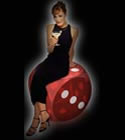


If you think your opponent is equally as probably to have two other small cards in the hole as another trey, you should at least call.
If you now catch a trey on fifth street to raise if you know this opponent would still bet if he had only a pair and four low cards.
Since you have seen another trey, it is now much more mathematically likely that you have the best high hand, and you are a favorite to scoop the pot.
Finally, as this last example shows, you need to complement mathematical conclusions with what you know about a player.
For example, some players almost always will raise with a hidden big pair in the hole and a small card up, trying to represent a strong low hand.
If this type of player raises on third street and then catches small cards on fourth and fifth streets, he is less likely to have a quality low hand, and the chances that he has a high hand have increased.
This would not be true if the raise came after several people with low cards already had limped in and if you know this player is reluctant to raise on big pairs in multiway pots.
In this situation, the quality low hand is very likely.
Another factor in reading hands and deciding how to play your own hand is the number of players in the pot.
People tend to play their hands much more straightforwardly in multiway pots.
This is also true when several players are yet to act.
So if a player bets in either of these situations ( especially with several low cards showing), you can be quite sure that he’s got a real best hand.


